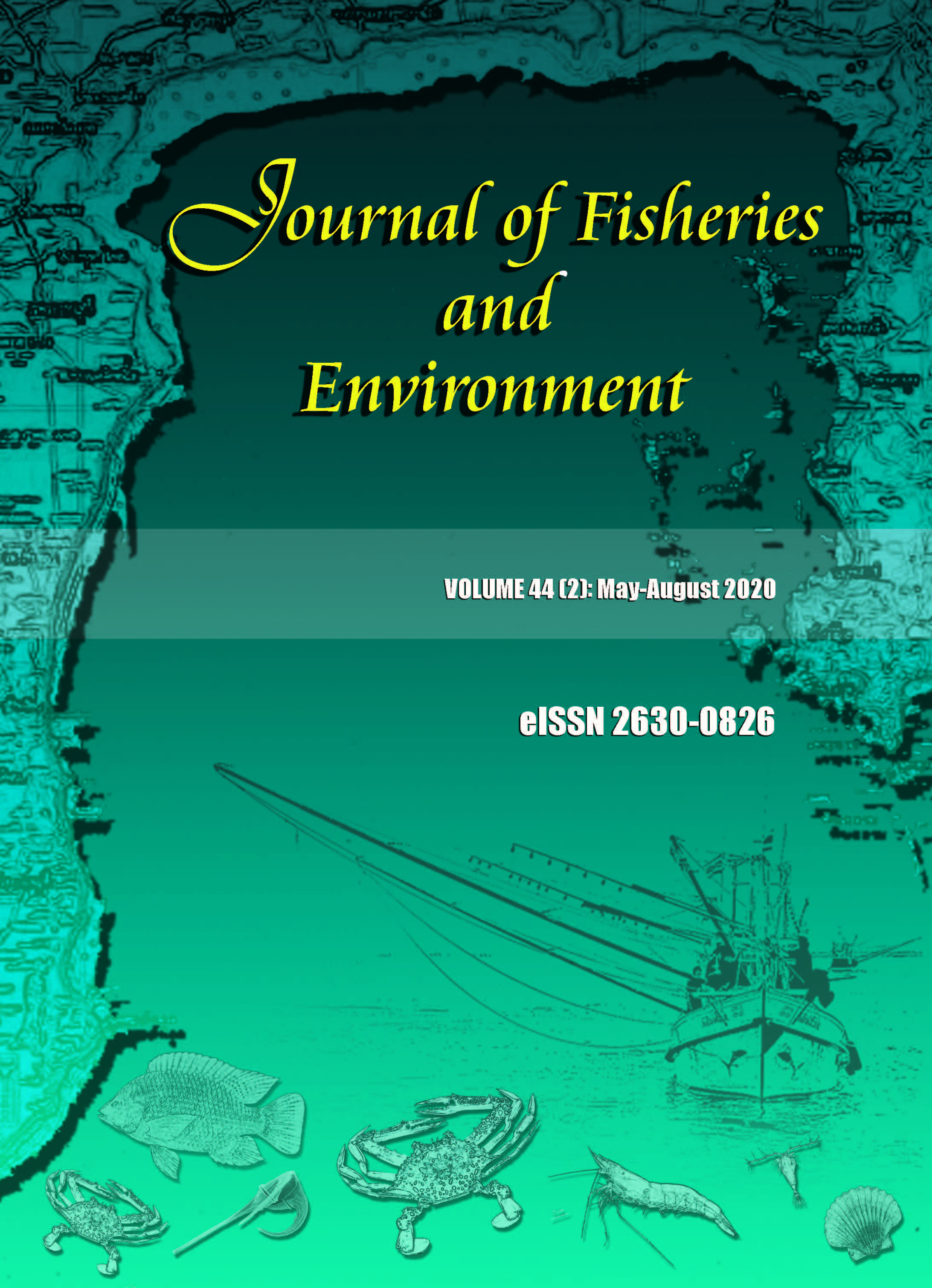Nutritional Properties of Fish Meal Produced from Fresh By-Products of Sardina pilchardus
Main Article Content
Abstract
In Morocco, fresh by-products of Sardina pilchardus from fish canneries are processed into fish meal. These by-products contain proteins, unsaturated fatty acids (omega-3), minerals and other beneficial elements for animal and human nutrition. The objective of our work was to characterize the nutritional properties of this fish meal produced using a low temperature treatment. The analysis of the nutritional composition of several batches produced during different seasons (throughout the year) showed that the composition was relatively constant. The average (mean±standard deviation) protein content (58.41±1.22 %), ash (21.03±2.15 %), fat (9.12±1.02 %), moisture (7.02±0.83 %) and salt (1.62±0.39 %) indicate the use of highly osseous and relatively oily raw materials. This fish meal contained a minor amount of histamine (concentration less than 500 mg·kg-1), which shows the use of a fresh raw material. The yields were, on average, 21.1±1.5 % for fish meal and 7.1±1.9 % for oil.
Article Details
References
Boland, M.J., A.N. Rae, J.M. Vereijken, M.P.M. Meuwissen, A.R.H. Fischer, M.A.J.S. van Boekel and W.H. Hendriks. 2013. The future supply of animal-derived protein for human consumption. Trends in Food Science and Technology 29(1): 62–73.
Cho, J. and I. Kim. 2011. Fish meal−nutritive value. Journal of Animal Physiology and Animal Nutrition 95: 685–692.
Department of Maritime Fisheries. 2010. Hygiene and HACCP principles guide Vol 10 fish meal and fish oil. Ministry of Agriculture and Maritime Fisheries. Department of Maritime Fisheries, Morocco. 191 pp.
Falch, E., T. Rustad and M. Aursand. 2006. By-products from gadiform species as raw material for production of marine lipids as ingredients in food or feed. Process Biochem 41(3): 666–674.
Food and Agricultural Organization of the United Nations (FAO). 2006. World agriculture: Towards 2030/2050. Food and Agricultural Organization of the United Nations. http://www.fao.org/docrep/016/ap106e/ap106e.pdf. Cited 30 Jan 2019.
Ghaly, A.E., V.V. Ramakrishnan, M.S. Brooks, S.M. Budge and D. Dave. 2013. Fish processing wastes as a potential source of proteins, amino acids and oils: A critical review. Journal of Microbial and Biochemical Technology 5: 107–129.
Jeon, Y.J., G.B. Heek and S.K. Kim. 1999. Improvement of functional properties of cod frame protein hydrolysates using ultrafiltration membranes. Process Biochemistry 35: 471–478.
Kristinsson, H.G. and B.A. Rasco. 2000. Fish protein hydrolysates: production, biochemical, and functional properties. Food Science and Nutrition 40(1): 43–81.
Lerk, P. and L. Bell. 1976. A rapid fluorimetric method for the determination of histaminein canned tuna. Journal of Food Science 41: 1282–1284.
Lordan, S., R.P. Ross and C. Stanton. 2011. Marine bioactives as functional food ingredients: potential to reduce the incidence of chronic diseases. Marine Drugs 9(6): 1056–1100.
Mackie, I.M. 1982. Fish protein hydrolysates. Process Biochemistry 17(1): 26–27.
Malde, M.K., S. Bügel, M. Kristensen, K. Malde and I.E. Graff. 2010. Calcium from salmon and cod bone is well absorbed in young healthy men: a double-blinded randomised crossover design. Nutrition & Metabolism 7(1): 61. DOI: 10.1186/1743-7075-7-61.
Miles, R.D. and F.A. Chapman. 2006. The Benefits of Fish Meal in Aquaculture Diets. Series of the Department of Fisheries and Aquatic Sciences, Florida Cooperative Extension Service, Institute of Food and Agricultural Sciences, University of Florida, Florida. 6 pp.
Ola, W., J.K. Stangeland, T.S. Fylling and G.H. Aas. 2017. Nutritional and functional properties of fish meal produced from fresh by-products of cod (Gadus morhua L.) and saithe (Pollachius virens). Heliyon 3(7): e00343. DOI: 10.1016/j.heliyon.2017.e00343.
Office National des Pêches (ONP). 2019. Coastal and artisanal fisheries in Morocco statistical report 2018. http://www.onp.ma/statistiques/. Cited 30 Jan 2019.
Phillips, C.J.C., P.C. Chiy, D.R. Arney and O. Kärt. 2000. Effects of sodium fertilizers and supplements on milk production and mammary gland health. Journal of Dairy Research 67: 1–12.
Prester, L. 2011. Biogenic amines in fish, fish products and shellfish: a review. Food Additives Contaminants 28(11): 1547–1560.
Rauscher-Gabernig, E., R. Grossgut, F. Bauer and P. Paulsen. 2009. Assessment of alimentary histamine exposure of consumers in Austria and development of tolerable levels in typical foods. Food Control 20(4): 423–429.
Rebeca, B.D., M.T. Pena-Vera and M. Diaz-Casteneda. 1991. Production of fish protein and hydrolysates with bacterial proteases; yield and nutritional value. Journal of Food Science 56(2): 309–314.
Shalaby, A.R. 1996. Significance of biogenic amines to food safety and human health. Food Research International 29(7): 675–690.
Šližytė, R., R. Mozuraitytė, O. Martínez-Alvarez, E. Falch, M. Fouchereau-Peron and T. Rustad. 2009. Functional, bioactive and antioxidative properties of hydrolysates obtained from cod (Gadus morhua) backbones. Process Biochemistry 44(6): 668–677.
Tome, D. and C. Bos. 2007. Lysine requirement through the human life cycle. Journal of Nutrition 137(6): 1642–1645.
Toppe, J., S. Albrektsen, B. Hopen and A. Aksnes. 2007. Chemical composition mineral content and amino acid and lipid profiles in bones from various fish species. Comparative Biochemistry and Physiology-Part B: Biochemistry & Molecular Biology 146(3): 395–401.
Valdimarsson, G. and D. James. 2001. World fisheries-utilisation of catches. Ocean and Coastal Management 44: 619–633.
Visciano, P., M. Schirone, R. Tofalo and G. Suzzi. 2012. Biogenic amines in raw and processed seafood. Frontiers in Microbiology 3: 188. DOI: 10.3389/fmicb.2012.00188.


